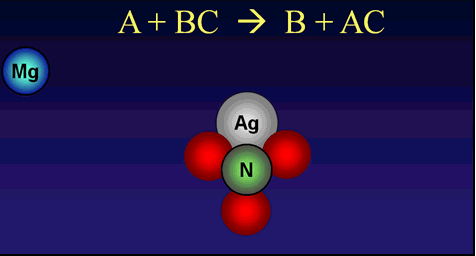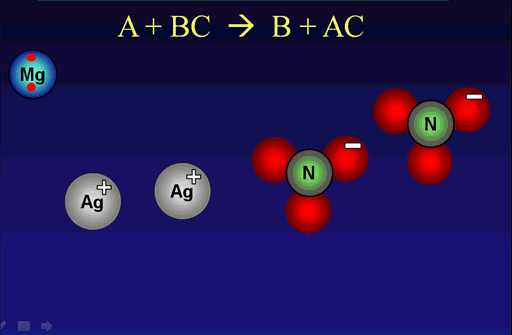Page 56: Objectives
1. React metals with water or dilute acid to produce hydrogen gas.
2. List metals in order of activity based on your observation.
3. Write balanced chemical equations for single replacement reactions.
Mg(s) + 2AgNO3(aq) --> 2Ag(s) + Mg(NO3)2(aq)
Mg(s) + 2Ag+(aq) + 2NO3-(aq) --> 2Ag(s) + Mg2+(aq) + 2NO3-(aq)
The fact that one metal can cause another metal to become undissolved is used for several practical purposes.
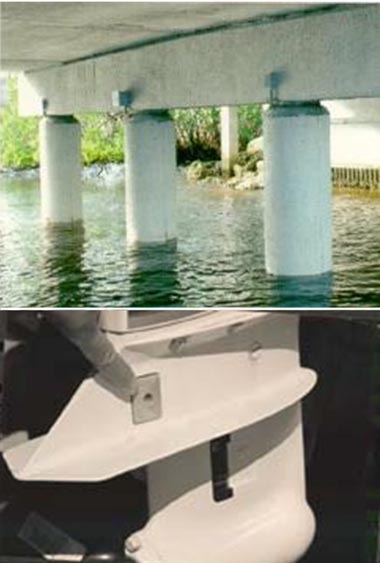
Sacrificial metal:
An example of a single replacement reaction is when one metal is sacrificed to save another metal. For example, concrete pillars have iron rebar in them for strength. However, salt water can quickly react with the iron to form iron (II) chloride. To prevent this, a metal like zinc or magnesium is attached to the rebar and will protect the iron. Here's the reaction:
Zn + FeCl2 -> Fe + ZnCl2
Notice the zinc metal becomes zinc chloride and the iron that had reacted with the chlorine becomes metallic iron. This preserves the iron rebar. In a similar manner the aluminum in boats are preserved by a piece of zinc or magnesium. See the person pointing to a plug of magnesium that is in embedded in the boat's rudder? That keeps the corrosive salt water from dissolving the aluminum; the magnesium dissolves in aluminum's place.
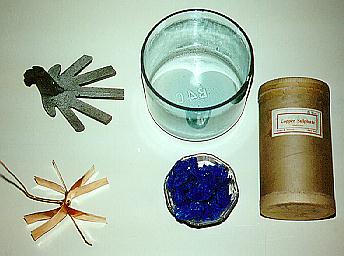
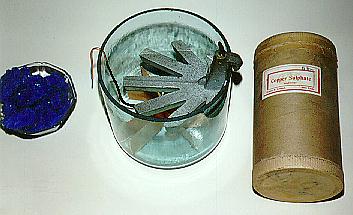
The fact that different metals have a different pull on electrons can be exploited in the making of batteries. An battery used in the 1800's for powering telegraph was the crows foot battery. It used zinc and copper. It worked because copper has a stronger pull on electrons than does zinc. So electrons would leave the zinc, power the telegraph, and end up going to the dissolved copper. The "crows foot" shaped zinc would eventually dissolve as copper in solution would turn to copper metal. Here are the reactions. The first two are called half reactions but show what gives electrons and what accepts electrons.
Zn(s) --> Zn2+(aq) + 2 electrons
Cu2+(aq) + 2 electrons --> Cu(s)
Zn(s) + Cu2+(aq) --> Cu(s) + Zn2+(aq)
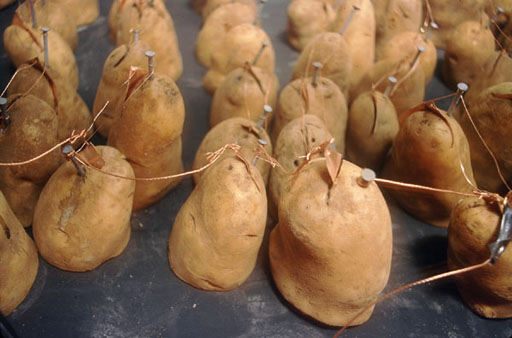
Another single replacement reaction involves how some metals will give their electrons to acids (H+) dissolving the metal and producing hydrogen gas. One interesting story was the use of 500 lbs of potatoes to make a battery.
Amos Latteier (inventor/speaker) set up the big potato battery in a back of a truck. The wire were hooked to a boom box. He drove around neighborhoods to show it off. Nails with zinc coating and the natural acid of the potato were the source of the electrical power. The copper pieces in the potato provided places where the electrons from the zinc were passed on to the acid. The first two equations track the electrons. The last one puts the equations together.
Zn(s) --> Zn2+(aq) + 2 electrons
2 electrons + 2H+(aq) --> H2(g)
Zn(s) + 2H+(aq) --> Zn2+(aq)+ +H2(g)
Experiment 8: Page 60
A. Physical and chemical properties of hydrogen and sodium
Hydrogen is produced by reacting sodium metal with water.
i) How is sodium stored? Why is this necessary?
Sodium is normally stored under mineral oil (a hydrocarbon with carbon chains of 15-40 carbons long). This is necessary because the oil keeps oxygen and water vapor from contacting the sodium. Sodium will react with water and oxygen. Sodium metal will not react with the mineral oil.
What do you observe with sodium metal is put into the water?
Write your observation.
iii) Write the formula equation for the reaction
Word equation: sodium + cold water --> sodium hydroxide + hydrogen gas
Formula equation:
Na(s) + H2O(l) --> NaOH(aq) +???
iv) Test with litmus paper. Is the solution acidic, basic, or neutral.
Note that NaOH(aq) above is actually Na+(aq) and OH-(aq). If there's OH-(aq) present, then the solution is basic (or called alkaline). If there is H+ ions present, then it's acidic.
v) This behavior of metal hydroxides is typical. Hydroxide of metals form what class of compounds?
Bases or Alkali. Al Kali is the Arabic name for the plant we call the saltwort plant. What was discovered a couple thousand years ago was that the ashes from the saltwort plant had the ability to neutralize the power of acids. These ash residues were also called bases. The ashes were looked upon as the basic makeup (the base) of the plant.
vi) List at least three physical properties of sodium and hydrogen
Sodium: The American Heritage dictionary defines sodium as, "A soft, light, extremely malleable silver-white metallic element that reacts explosively with water". "soft" is a physical property. Light (meaning low density) is a physical property. "Extremely malleable" is another physical property. "silver-white" is a physical property. "Metallic" is a physical property. "Reacts explosively with water" is a chemical property because they are remarking on its behavior with other compounds.
Hydrogen: The American Heritage dictionary defines sodium as, "A colorless, highly flammable gaseous element, the lightest of all gases and the most abundant element in the universe,..." The description "colorless" is a physical property. "Highly flammable" is a chemical property. "Gaseous" or gas would be a physical property. "Lightest of all gases" is density, which is a physical property. "The most abundant element in the universe" is neither a physical or chemical property.
vii) Flammability of hydrogen; what happens when a lighted sprint is brought to the mouth of a test tube or a beaker containing hydrogen?
You should remember that from the demonstration. (In a test tube, the quick burning of hydrogen builds up quick pressure forcing gases out the mouth of the test tube. That makes a characteristic "whistling pop" sound.)
B. Activity of metals.
a. Metals in cold water
Write word and formula equations for the other metals that react with cold water
WORD EQUATION:
Lithium + water --> Lithium hydroxide + hydrogen
Potassium + water --> Potassium hydroxide + hydrogen
Barium + water --> Barium hydroxide + hydrogen
Calcium + water --> Calcium hydroxide + hydrogen
FORMULA EQUATION:
2Li(s) + 2H2O(l) --> ??? + H2(g)
2K(s) + 2H2O(l) --> 2KOH(aq) + ???
Ba(s) + 2H2O(l) --> ??? + H2(g)
Ca(s) +??? --> Ca(OH)2(aq) + ???
(Note: how these were balanced)
Experiment 8: page 61
b. Metals and dilute acid
Write a word and formula equation for each metal that reacted with dilute acid.
I did one of these in the potato battery example above.
WORD EQUATIONS:
Zinc + dilute acid --> A salt of zinc + hydrogen gas
(The salt depends on which acid was used. If sulfuric acid, then the salt is zinc sulfate. If hydrochloric acid, then the salt is zinc chloride.)
Iron + dilute acid --> A salt of iron + ???
Tin + dilute acid --> ??? + hydrogen gas
Magnesium + dilute acid --> ??? + ???
FORMULA EQUATIONS:
Zn(s) + 2H+(aq) --> Zn2+(aq) + H2(g)
(Note: the negative ion, such as Cl- or SO42-, is left out since we aren't told what specific acid is used)
Fe(s) + 2H+(aq) --> Fe2+(aq) + H2(g)
(Note: iron can exist as Fe3+ but normally when reacted with an acid it goes to Fe2+ because Fe3+ has a stronger pull on electrons than the acid (H+). )
Sn(s) + 2H+(aq) --> ??? + H2(g)
Mg(s) + 2H+(aq) --> ??? + ???
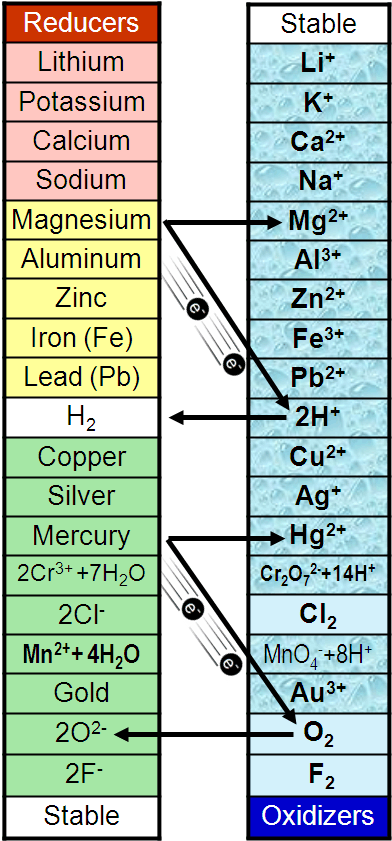
The list on the left is a activity series (reactivity series) that I designed. The metals are arranged so that the ones near the top tend to give away their electrons easily. The ones at the bottom have a strong pull on electrons. The example, I show is magnesium metal giving its electrons to acid (H+). In the process magnesium metal becomes Mg2+ and the H+ becomes H2 gas. I show the water drop background to remind you that the metal ions are dissolved. The metal in the left column are solid.
Any element (metal) in the left column will give its outer electrons to any element (ion) in the right column that sits below it. For example, lithium will give its electron to K+, Ca2+, and all in the right column list. Li+ ion will not give an electron away because it has already lost its electron.
Look at zinc and copper since we've talked about them earlier (crows foot battery). Notice zinc is above copper. That means zinc will give its outer 2 electrons to copper ions (Cu2+).
Remember the potato battery? Zinc gives its electrons to the acid (H+) in the potato. This activity table confirms that. Zinc sits above H+. So zinc metal becomes Zn2+ ion as its electrons turn 2H+ into H2 gas.
Questions
1. Write balanced chemical equations for the following single replacement reactions. If no reaction occurs, write N.R.
a. Li + H2O
2Li(s) + 2H2O(l) -->
b. Mg(NO3)2 + Ca
Mg(NO3)2(aq) + Ca(s) --> Ca(NO3)2(aq) + ???
(Note: In my table above calcium metal sits above magnesium ion (Mg2+). So that means this reaction will happen. Calcium gives its outer two electrons to magnesium ion and the magnesium ion becomes the metal magnesium, also called elemental magnesium)
c. K + HCl
2K(s) + 2H+(aq) + 2Cl-(aq) --> 2K+(aq) + 2Cl-(aq) + H2(g)
(Note: In the table above, potassium sits high above H+, so there will be an energetic passing of electrons from potassium (K) to the acid (H+). With the heat generated, hydrogen gas will catch fire. Also remember that the potassium metal will react with the water as well. So the below reaction accounts for the reaction of potassium with water)
4K(s) + 2H+(aq) + 2Cl-(aq) + 2H2O(l) --> 2KCl(aq) + 2H2(g) + 2KOH(aq)
d. Fe + Na2SO3
Fe(s) + Na2SO3(aq) --> N. R.
Fe(s) + 2Na+(aq) + SO32-(aq) --> N. R.
(Note: In the table above, iron (Fe) sits below sodium (Na+). So it will not give its electrons to sodium. If this was sodium metal (Na) and iron sulfite, then yes, the sodium metal will give its outer electron to the iron ion.)
e. Cu(NO3)2 +Zn
Cu(NO3)2(aq) + Zn(s) -->
Cu2+(aq) + 2NO3-(aq) + Zn(s) --> Cu(s) + Zn2+(aq) + 2NO3-(aq)
(Note the bottom equation shows the charges and lets us use the activity table easier. Zinc metal sits above the copper ion (Cu2+), so it will give its electrons to the copper ion. In the process zinc dissolves and becomes Zn2+ and the copper ion plates out and become metallic copper. Visually, a zinc strip placed in a solution of copper (II) nitrate will turn to a copper color as zinc dissolves and copper metal plates out on the zinc.)
2. Complete the word equation and write a formula equation for each of the following reactions.
a. potassium + ____________ --> hydrogen + potassium hydroxide
To find the missing reactant, we could write the equation:
K + ? --> H2 + KOH
What we see is that the products have extra hydrogen and oxygen.
Formula Equation:
2K(s) + ??? --> H2(g) + 2KOH(aq)
b. Iron + ___________ --> hydrogen + iron (II) sulfate
What we see is that the products have extra hydrogen and sulfate. That's a clue that sulfuric acid was used (H2SO4). So the missing word is sulfuric acid.
Formula Equation:
Fe(s) + H2SO4(aq) --> H2(g) + ???(aq)
c. Zinc _________ + magnesium --> zinc + magnesium acetate
What we see is that the products contain the word "acetate", so that means we must have started with zinc acetate. In the table above magnesium metal sits above zinc ion (Zn2+), so this reaction will occur.
Formula Equation: (Note: either of the equations below is OK. The lower equation shows the ionic equation, which may be clearer to you because you see the Zn2+ that is listed in the activity table above.)
Zn(C2H3O2)2(aq) + Mg(s) --> Zn(s) + ???
Zn2+(aq) + 2C2H3O2-(aq) + Mg(s) --> Zn(s) + Mg2+(aq) + 2C2H3O2-(aq)
d. silver nitrate + copper --> copper(II) nitrate + ________________
What we see is that the products don't mention silver.
Formula Equation:
2AgNO3(aq) + Cu(s) --> ???(aq) + 2Ag(s)
Ag+(aq) + 2NO3-(aq) + Cu(s) --> Cu2+(aq) + 2NO3-(aq) + 2Ag(s)
(Note: Copper metal does sit above the Ag+ ion so it will give its electrons to the silver ion. Also, note the lower equation shows the ionic equation, which may be clearer to you because you see the Ag+ that is listed in my activity table.)
3. Test your logic. You have been given four metals labeled A, B, C, D, and aqueous solutions of each. Hydrochloric acid is also available. The following information was obtained from a series of separate experiments. After each statement, write down what you can conclude about the activity of the metals from the experimental results:
a. Only B and D put into HCl(aq) release hydrogen gas
This means is that these reactions took place:
B(s) + H+(aq) --> B+(aq) + H2(g)
D(s) + H+(aq) --> D+(aq) + H2(g)
In the list of reactivity above, this information puts the metals of B and D higher on the list than H+ ions (acids) So let's write (Note: the charge on the metals can be higher the +1):
Metals B and D |
--> B+ and D+ |
H2 |
<-- 2H+ |
Because statement (a) said, "Only B and D..." that places A and C below hydrogen. So we can add the following row:
Metals B or D |
--> B+ or D+ |
H2 |
<-- 2H+ |
A or C |
A+ or D+ |
The above table tells us that metals B or D will react with acid (H+) because they sit above the H+ row. The table also says that metals A or B will not react with acid..
b. Metal A put into a solution of C causes metallic C to form.
Even those it doesn't explicitly say metal A went into solution (as A ion), that has to happen because A gave away its electrons. So here is the equation:
A(s) + C+(aq) --> C(s) + ???
If metal A gives its electrons to metal C's ion, that places metal A higher on the reactivity list:
Metal A |
--> A+ |
Metal C |
<--C+ |
c. Nothing happens when B is placed into a solution of D.
This means that metal B must be below metal D on the activity (reactivity) list.
Metal D |
D+ |
Metal B |
B+ |
d. From the results of these experiments, prepare a vertical activity list of the metals A, B, C, D, and hydrogen.
See if you can put the table together.
